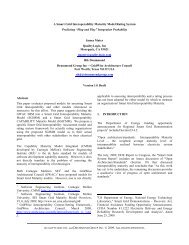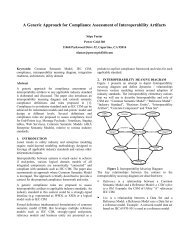Towards Interoperability Standards in Indian Power Sector ...
Towards Interoperability Standards in Indian Power Sector ...
Towards Interoperability Standards in Indian Power Sector ...
You also want an ePaper? Increase the reach of your titles
YUMPU automatically turns print PDFs into web optimized ePapers that Google loves.
3. LEVELS OF INTEROPERABILITY<br />
In reference [8] titled "Role of <strong>Interoperability</strong> <strong>in</strong> <strong>Indian</strong><br />
power sector", some <strong>in</strong>itial work is carried out on the<br />
<strong>in</strong>teroperability scenario <strong>in</strong> and among control centres at<br />
state, regional and national levels <strong>in</strong> India. Build<strong>in</strong>g on this<br />
<strong>in</strong>itial research, the work<strong>in</strong>g group on <strong>in</strong>teroperability<br />
(WG1) is currently <strong>in</strong>volved <strong>in</strong> gather<strong>in</strong>g <strong>in</strong>formation on all<br />
aspects of <strong>in</strong>teroperability <strong>in</strong> <strong>Indian</strong> scenario.<br />
An important early step taken by the GridWise Architecture<br />
Council (GWAC) <strong>in</strong> its mission, was to develop a common<br />
understand<strong>in</strong>g of <strong>in</strong>teroperability, the various levels of<br />
<strong>in</strong>teroperability, and issues of concern. To achieve this, a<br />
context-sett<strong>in</strong>g framework document [9] was developed to<br />
organize concepts and establish common term<strong>in</strong>ology so<br />
that <strong>in</strong>teroperability issues can be identified and debated,<br />
and actions prioritized and coord<strong>in</strong>ated across the electric<br />
power community. A context sett<strong>in</strong>g framework provides a<br />
broad and neutral ground upon which the stakeholders can<br />
communicate.<br />
Similar to the approach of GWAC, this paper serves the<br />
role of sett<strong>in</strong>g the context for <strong>in</strong>teroperability for coord<strong>in</strong>ation<br />
with<strong>in</strong> the work<strong>in</strong>g group, as well as other<br />
work<strong>in</strong>g groups. The <strong>in</strong>teroperability framework should be<br />
developed not only to reflect the exist<strong>in</strong>g scenario of<br />
<strong>in</strong>teroperability <strong>in</strong> <strong>Indian</strong> power sector but also to provide a<br />
vision for future development of a seamless <strong>in</strong>tegrated<br />
<strong>in</strong>formation network.<br />
3.1. Levels of <strong>Interoperability</strong><br />
<strong>Interoperability</strong> occurs <strong>in</strong> various levels or layers. These<br />
layers span the details of the technology <strong>in</strong>volved to l<strong>in</strong>k<br />
systems together, to the understand<strong>in</strong>g of the <strong>in</strong>formation<br />
exchanged, to the bus<strong>in</strong>ess processes and organizational<br />
objectives that are represented <strong>in</strong> bus<strong>in</strong>ess, economic, and<br />
regulatory policy. Three broad levels were identified by the<br />
work<strong>in</strong>g group namely, Communication technology (CT),<br />
Information Technology (IT) and Operation Technology<br />
(OT). The scope of these levels are as described below.<br />
Figure 2: Levels of <strong>in</strong>teroperability and cross cutt<strong>in</strong>g issues<br />
3.1.1. Communication Technology (CT)<br />
This level of <strong>in</strong>teroperability address the the tenical<br />
aspects of communication between the two systems. This<br />
covers def<strong>in</strong><strong>in</strong>g the specifications of basic physical medium<br />
of connection, the network address<strong>in</strong>g and identification<br />
mechanism and the protocols for communication.<br />
3.1.2. Information Technology (IT)<br />
Even though the basic connectivity protocols are<br />
satisfied and a certa<strong>in</strong> amount of <strong>in</strong>formation is<br />
communicated between two systems, the <strong>in</strong>formation may<br />
not be useful until it is semantically understood on a<br />
common basis. This can be achieved by conform<strong>in</strong>g the<br />
<strong>in</strong>formation be<strong>in</strong>g communicated to a standard <strong>in</strong>formation<br />
model at a higher level of <strong>in</strong>teroperability. As this level the<br />
semantics of the content that is communicated is<br />
standardised.<br />
3.1.3. Operation Technology (OT)<br />
At this level, the bus<strong>in</strong>ess context for communication<br />
between any two systems needs to be standardised. This<br />
def<strong>in</strong>es the high level functions or services that are to be<br />
carried out to achieve certa<strong>in</strong> organisational objectives. OT<br />
answers why <strong>in</strong>formation is to be exchanged, IT answers<br />
what <strong>in</strong>formation is to be exchanged, CT answers how<br />
<strong>in</strong>formation is to exchanged.<br />
4. INFORMATION NETWORK PARTICIPANTS OF<br />
INDIAN POWER SECTOR<br />
In this section, a model is presented which depicts the<br />
“logical” <strong>in</strong>formation network of <strong>Indian</strong> power sector. The<br />
logical <strong>in</strong>formation network is essentially a graph with<br />
nodes as <strong>in</strong>formation sources and s<strong>in</strong>ks, which are<br />
<strong>in</strong>terconnected with <strong>in</strong>formation branches. Information<br />
travels from source nodes to dest<strong>in</strong>ation nodes over the<br />
<strong>in</strong>formation l<strong>in</strong>ks across devices belong<strong>in</strong>g to different<br />
systems, organizations, people, <strong>in</strong>formation representation<br />
formats and communication protocols. For example,<br />
national load desptach center (NLDC) and regional load<br />
despatch center (RLDC) are two nodes <strong>in</strong> the network<br />
which share <strong>in</strong>formation over a communication l<strong>in</strong>k. The<br />
details of the underly<strong>in</strong>g “physical” network are not covered<br />
<strong>in</strong> the model. The objective of mapp<strong>in</strong>g this <strong>in</strong>formation<br />
network is to identify all the participants and the types of<br />
<strong>in</strong>formation that is be<strong>in</strong>g exchanged between these<br />
participants. It is attempted to make this network model as<br />
comprehensive as possible cover<strong>in</strong>g all aspects of power<br />
system schedul<strong>in</strong>g, operation, control and commercial<br />
settlement practices be<strong>in</strong>g followed <strong>in</strong> current <strong>Indian</strong><br />
scenario.<br />
Fig. 3. presents the nodes participat<strong>in</strong>g the <strong>in</strong>formation<br />
network. The nodes can be categorised as belong<strong>in</strong>g to<br />
different k<strong>in</strong>ds of utilities as described below.<br />
Grid-Interop Forum 2010







